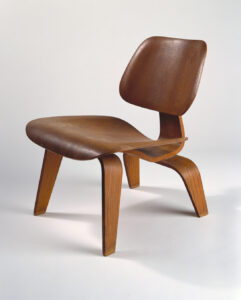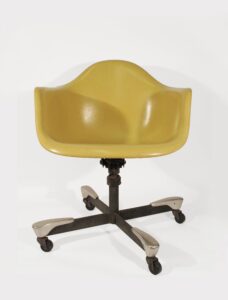Charles Ormond Eames and Ray Bernice Alexandra Kaiser met at the Cranbrook Academy of Art in Michigan, where they both studied design and architecture in the late 1930s. They eventually married and developed a joint career based on a commitment to devising "elegant solutions" to design problems.
Ray, a former painter, had assisted Charles and Eero Saarinen with a series of molded plywood chairs and tables — an experience that benefited the couple when they moved to Los Angeles in 1941. There they perfected their process of woodworking and made splints, litters, and aircraft parts for the armed forces during World War II.
In 1946 the Museum of Modern Art, New York, showcased Charles and Ray Eames's new furniture technology. This exhibition secured them a contract with the Herman Miller company in Michigan and initiated a 30-year relationship that produced many of the enduring furniture designs of the twentieth century.
In the late 1940s, the Eameses designed a house for the Case Study House Program sponsored by Arts and Architecture magazine. From the 1950s onward, they expanded their design and architectural practice to include the production of films and exhibitions — including Toccatta for Toy Trains (1957) and Mathematica(1961) — that used a variety of media to engage the imagination of the public.
 Charles Eames, Ray Eames, Herman Miller Inc.DCM (Dining chair metal)1946
Charles Eames, Ray Eames, Herman Miller Inc.DCM (Dining chair metal)1946 Charles Eames, Ray Eames, Herman Miller Inc.Walnut stool B1960
Charles Eames, Ray Eames, Herman Miller Inc.Walnut stool B1960 Charles Eames, Ray EamesLa Fonda chair1961
Charles Eames, Ray EamesLa Fonda chair1961 Charles Eames, Ray Eames, Herman Miller Inc.LCW (Lounge chair wood)1946
Charles Eames, Ray Eames, Herman Miller Inc.LCW (Lounge chair wood)1946 Charles Eames, Ray Eames, Herman Miller Inc.Walnut stool Cdesigned 1960
Charles Eames, Ray Eames, Herman Miller Inc.Walnut stool Cdesigned 1960 Charles Eames, Ray Eames, Herman Miller Inc.Walnut stool Adesigned 1960
Charles Eames, Ray Eames, Herman Miller Inc.Walnut stool Adesigned 1960 Charles Eames, Ray EamesLa Fonda chair1961
Charles Eames, Ray EamesLa Fonda chair1961 Charles Eames, Ray EamesLa Fonda chair1961
Charles Eames, Ray EamesLa Fonda chair1961 Charles Eames, Ray Eames, Evans Products Company, Molded Plywood DivisionLeg Splint, Wrapped1942
Charles Eames, Ray Eames, Evans Products Company, Molded Plywood DivisionLeg Splint, Wrapped1942 Charles Eames, Ray Eames, Banner Metals, Herman Miller Inc.Wire chair (DKR1)1951
Charles Eames, Ray Eames, Banner Metals, Herman Miller Inc.Wire chair (DKR1)1951 Charles Eames, Ray Eames, Herman Miller Inc.Soft Pad Sofa1984
Charles Eames, Ray Eames, Herman Miller Inc.Soft Pad Sofa1984 Charles Eames, Ray EamesDAT (Desk Armshell Tilt)1950
Charles Eames, Ray EamesDAT (Desk Armshell Tilt)1950